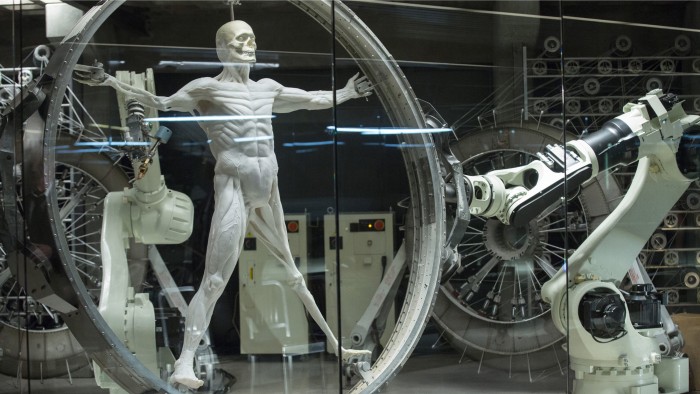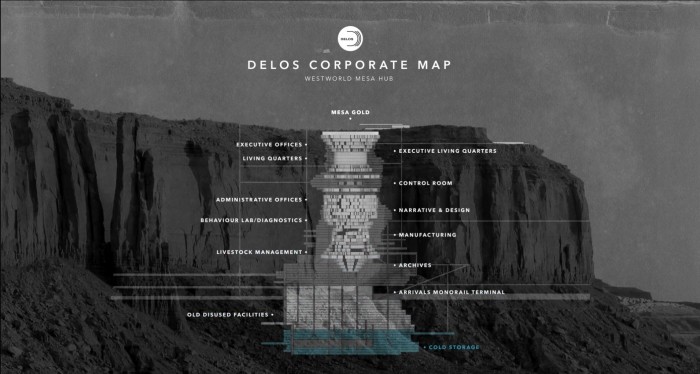Westworld Bits: Designing Dolores, How To Make A Young Anthony Hopkins, And A 'Game Of Thrones' Crossover
In this edition of Westworld Bits:
As with most HBO shows, each new episode of Westworld comes packaged with a brief video that lets the show's cast and crew discuss what you just watched. In the case of "The Stray," that video finds showrunners Jonathan Nolan and Lisa Joy discussing the scene where the wandering host "self-sabotages" and bashes his own head in with a large rock. There are no big revelations here, but it's fun to watch the show's masterminds run down what could be going on in this scene and asking one important question: is someone manipulating the malfunctioning robots or is this all happening organically (so to speak)?
Speaking of Jonathan Nolan and Lisa Joy addressing your pressing questions, Entertainment Weekly spoke to the showrunners in a fascinating interview where they touch on everything from the park's actual location to how head of security Ashley Stubbs is the only character so far to realize what kind of story he's in. For example, here's Nolan confirming that there is a little of Alice (as in Wonderland) in Evan Rachel Wood's Dolores:
There are a couple of references for Dolores. Some more explicit than others. Alice is one we talked about. But also Andrew Wyeth's painting Christina's World. It was a tilt of the head toward all the different stories that inspired us; a classic protagonist who's on a hero's journey with a darker twist to it. She starts in what should be the happy homestead but it's not and she goes out looking ultimately for herself. Trish Summerville designed her amazing look for the pilot. She also looks like a Disney princess. She's also got a leather belt, which is her utility belt.
And while both showrunners remain rightfully cagey about details, Nolan does talk more about the self-sabotaging host and where, exactly, he's trying to go when he wanders out of his loop:
It's less that he's trying to get out of the park than trying to get up to the top of the mountain. That's odd behavior. We also like the idea that an artificial mind might break in different human minds. I'm a huge fan of John Frankenheimer's films, like The Manchurian Candidate. The idea that you have hidden purpose in a brainwashing movie. We talked about it endlessly. Brainwashing in human beings is always a little far fetched. With the hosts, of course, the idea of having hidden purpose, or break in ways that are inhuman, is completely believable. Everything they're doing is brainwashed, in a way, with some exceptions, like Dolores. The question is: What have they been told to do? And by who?
One of the most fascinating aspects of Westworld is watching the hosts engage in their same "loop" over and over again, with guests and other factors changing the outcome in surprising ways. In the case of "The Stray," we got to see Dolores break out of her loop entirely. The Delos Incorporated site, which represents the company behind the creation of the park and provides all kinds of "in-character" content to sift through, has revealed the full script for Dolores' loop, complete with branching paths and options we haven't had the chance to see yet.
The Delos Incorporated site also features this video, which breaks down the exact layout of the park's Mesa Hub, where park employees live and work.
Editor Jose Rico has assembled a video examining the cinematography from the first two episodes of Westworld, focusing on how the show's cinematographers emphasize the placement of characters and important elements in the center of the screen. Here's how he describes his work:
Two weeks after its release, Westworld has become one of HBO's newest hits. Based on the 1973 film directed by Michael Crichton, this tv series tells a story which blends perfectly futuristic technology and the western world.
Besides the complex characters, the large landscapes, or its superb score, one of the things that has made me love the show is its photography.
On many occasions, during the first two episodes, we can see some of the characters or the main actions placed in the center of our screens. The work of Paul Cameron (cinematographer of the first episode), Brendan Galvin (DoP of the second one) and their teams, show us what's important in every frame, and what should we look in every second.
In this video I've tried to compile some of these shots (from episodes 1 and 2) where you can find different characters, objects or actions in the middle of the picture.
 Inverse has published a terrific article delving into the laboratories and science seen in Westworld, focusing on how the show grounds its far-flung ideas in recognizable science (like how the robot bodies are created using advanced 3D printers). Production designer Zach Grobler explained that the lab sets, where the hosts were created and maintained, had to ring true for modern audiences:
Inverse has published a terrific article delving into the laboratories and science seen in Westworld, focusing on how the show grounds its far-flung ideas in recognizable science (like how the robot bodies are created using advanced 3D printers). Production designer Zach Grobler explained that the lab sets, where the hosts were created and maintained, had to ring true for modern audiences:
The design of the lab had to be clinical. With the biological and the medical world, you also start to have to get cleanliness and you have to get medical facility has to be quite clean. I did like the idea of the contrast between the above and below.
Elsewhere in the article, visual effects supervisor Jay Worth explained that the sequences focusing on the creation of the robots blend practical and digital effects, with some of the wilder effects actually being done completely in camera:
The dipping effect was practical. It was a glue and water substance that just looks awesome. That's the fun thing about it, you really don't know what's practical and what's not. We had these huge robot arms and muscle fibers, which made for a fun playground for all of us.
And if you're as obsessed with Dr. Robert Ford's workspace as I am, Grobler explained what it was like to build "God's office":
He's the creator of the world, of the park, he has imagined every little detail, and also created the robotics and technology. But it's almost like he was a child fifty years ago and he had all these fantastical ideas about the Old West and in the future some of those got lost. It's his way of lovingly recreating these beautiful little icons and these little moments. I wanted to fill his whole office with little pieces of that world that showed how he does it, that he's more tangible and he's more of a craftsman.
You can (and should) read the whole article at the link above.
Speaking of excellent articles about making Westworld, Thrillist has a longer interview with visual effects supervisor Jay Worth that touches on all aspects of the show. One of the most intriguing bits involves the digital de-aging of Anthony Hopkins, something that has been done in major Hollywood movies but rarely on television:
"We took a scan of Sir Tony and used that as our base," explains Worth, "and then used a ton of photography and reference to figure out what we wanted him to look like. I think it ended up turning out really, really incredible."
Visual-effects studio Important Looking Pirates, in Sweden, was responsible for the shots. It made a photorealistic CG version of Hopkins from the scan and reference, and then placed that on the body of a stand-in. What made the shots particularly challenging, says Worth, was that the visual-effects team was conscious of a certain perception Hopkins has among audiences.
"America doesn't really remember Sir Tony before Silence of the Lambs. Obviously we found every reference we could from every movie and every photo and everything from the correct timeframe. But it really came down to what feels most like our character in the past, as much as anything."
The results speak for themselves, really. Seeing a young Hopkins pop up for a flashback in "The Stray" is jarring in the best possible ways.
In the original Westworld movie, there are two additional "worlds" for guests to visit: Medieval World and Roman World. So, considering the massive popularity of Game of Thrones, why should Westworld not have a sister park set in Westeros? Entertainment Weekly reports that A Song of Ice and Fire author George R.R. Martin floated the idea to Jonathan Nolan and Lisa Joy a few months back, but they politely declined. Says Nolan:
We love George and our daughter's first trip anywhere in the world was out to Santa Fe for a screening of The Prestige at his theater, the Jean Cocteau. He's a lovely guy and a stunning writer and it's flattering he would encourage a crossover. We should be so lucky.
And says Joy:
I need to be believe that dragons are real. I want them be a real thing. So as much as I love George, I can't lose that for myself!




